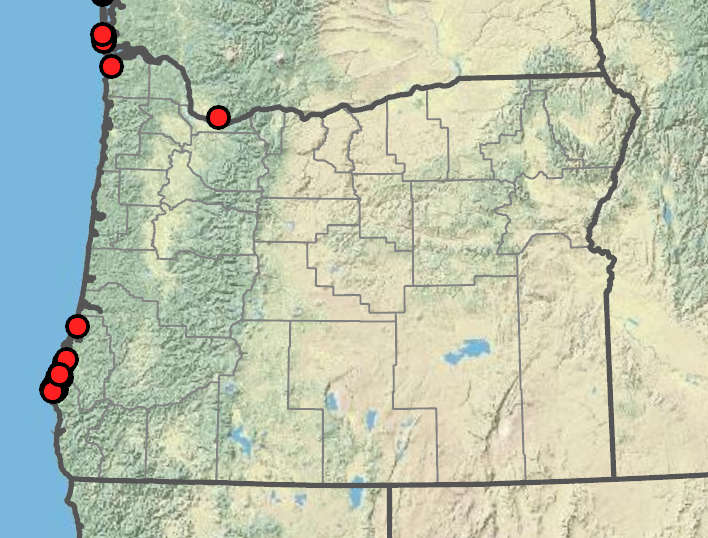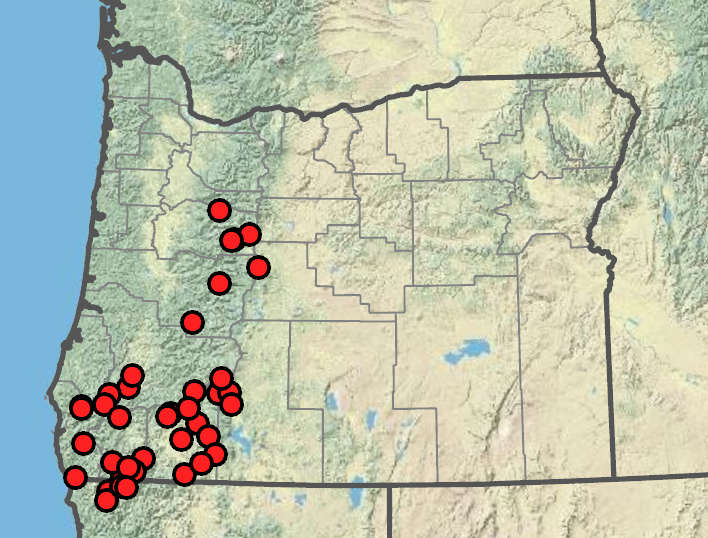Juncus canadensis
Juncus exiguus
Canada rush, Canadian rush
Klamath rush, weak rush
basal and cauline; round; hollow, septate, 1–2 mm wide;
auricles 1–1.2 mm.
lacking blades;
proximal sheaths smooth (at 10×);
distal sheaths 3–14 cm;
distal half green to pale brown; thin; dull, not papillose; nerves prominent;
apices symmetrical, unwinged; thin; dark and often slightly inrolled towards stem.
panicles of 3–50 clusters; clusters 5–50-flowered, not obscured by inflorescence bract.
loose clusters;
branches visible;
inflorescence bracts not swollen; erect in fruit.
tepals 6, green; reddish, or pale brown;
tips acuminate;
stamens 3;
filaments 0.8–1.5 mm;
anthers 0.3–0.5 mm;
styles 0.2–0.3 mm.
tepals 6, usually mid to dark brown-striped;
stamens 3;
filaments 0.3–0.8 mm;
anthers (0.3)0.4–0.8(0.9) mm;
styles 0.2–0.3 mm.
usually 0–1 mm longer than the tepals, dark brown, 1-chambered.
2.2–3 mm; shorter than or equaling the tepals; light to dark brown, 1-chambered.
narrowly ellipsoid to linear, 1.25–1.9 × 0.2–0.25 mm;
bodies 0.5– 0.8 mm; tails 0.3–0.5 mm, 0.5–1 times as long as seed body.
0.35–0.5 × 0.2–0.25 mm, reticulate, apiculate.
=80.
Juncus canadensis
Juncus exiguus
Shores, ponds, peatlands, disturbed sandy acidic wet ground, cranberry farms, ditches. 0–100 m. Est. WA; north to British Columbia; eastern North America; Europe, New Zealand. Exotic.
This species was introduced by cranberry agriculture and is spreading into natural wetlands. Some authors suggest rare flowers have 6 stamens.
Shores, wet meadows, marshes, stream banks, springs, peatlands. 900–2300m. CR, Sisk, Casc. CA; southeast to AZ. Native.
The fresh upper stems of this species are variable, but are often smooth, green, and shiny. Upon drying they become blue-green and clearly ridged, so the plants look quite different in the field and in a herbarium. Similar Juncus hesperius is found at lower elevations and has papillose proximal sheaths; J. exiguus is montane and is never papillose.
Peter Zika
Peter Zika
- Local floras:
BC,
OR,
WA
- Local Web sites:
Flora NW,
PNW Herbaria
WildflowerSearch
iNaturalist (observations)
USDA Plants Database
- LBJ Wildflower Center
- SEINet
- Plants of the World Online
- Encyclopedia of Life
- Wikipedia
- Google Image Search
- Local floras:
CA,
OR
- Local Web sites:
CalFlora,
CalPhotos,
Flora NW,
PNW Herbaria
WildflowerSearch
iNaturalist (observations)
- LBJ Wildflower Center
- SEINet
- Plants of the World Online
- Encyclopedia of Life
- Wikipedia
- Google Image Search

